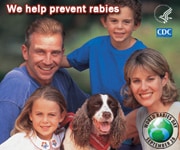Is Rabies in Your State?
Each year, scientists from the Centers for Disease Control and Prevention (CDC) collect information about cases of animal and human rabies from state health departments and summarize the information in an annual report. The most recent report entitled “Rabies surveillance in the United States during 2018”external icon contains the epidemiologic information on rabies during 2018.
During 2018, 54 jurisdictions reported 4,951 cases of rabies in animals and 3 cases in humans to CDC. This total represented an increase of 11.2% as compared to 2017 (4,454 rabid animals and 2 human cases of rabies).

Wild animals accounted for 92.7% of reported cases of rabies in 2018. Bats were the most frequently reported rabid wildlife species, followed by raccoons, skunks, and foxes.
Domestic species accounted for 9 percent of all rabid animals reported in the United States in 2018. From 2017 to 2018, the number of reported rabid dogs increased slightly (62 to 63), and the number of reported rabid cats decreased (from 276 to 241). The number of rabid cattle decreased (36 to 33), while the number of rabid horses and mules stayed the same (13).
Cases of human rabies cases in the United States are rare, with only 1 to 3 cases reported annually. Twenty-five cases of human rabies have been reported in the United States in the past decade (2009-2018).

